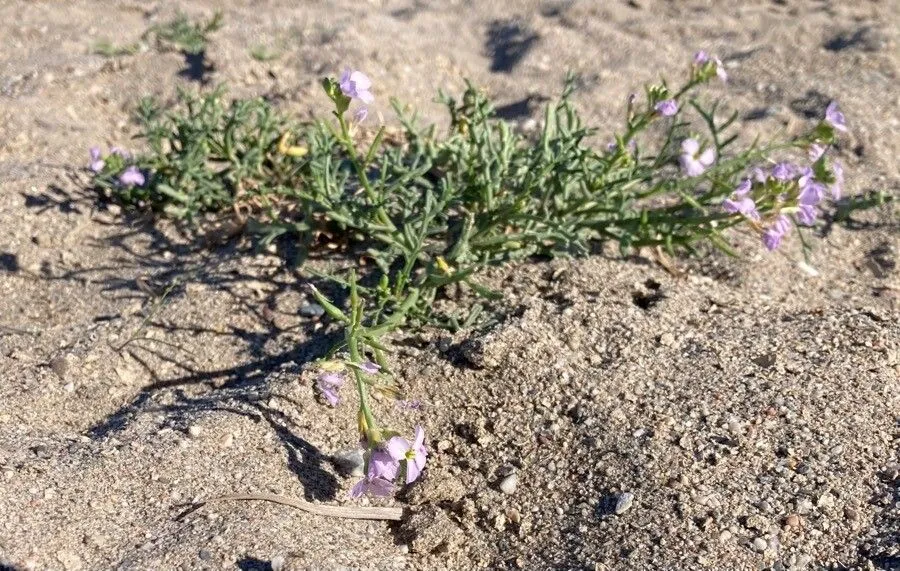
Author: Scop.
Bibliography: Fl. Carniol., ed. 2, 2: 35 (1771)
Year: 1771
Status: accepted
Rank: species
Genus: Cakile
Vegetable: False
Observations: Macaronesia, European and Medit. coasts
Sea rocket, scientifically known as Cakile maritima, is a resilient coastal plant that thrives in the challenging environments of Macaronesia, as well as the European and Mediterranean coasts. This tenacious species belongs to the Brassicaceae family, a diverse group commonly known as the mustard family.
Cakile maritima was first described and classified in 1771 by the noted botanist Giovanni Antonio Scopoli in the second edition of his work, “Flora Carniolica”. This historical reference underscores the longstanding recognition of the plant’s unique adaptations and ecological contributions to its native habitats.
Often found in sandy dunes and coastal regions, sea rocket has developed a robust mechanism to withstand saline conditions, strong winds, and shifting sands. Its fleshy, succulent leaves are adept at storing water, enabling the plant to survive in environments where moisture is a scarce commodity. The plant’s low, spreading form helps minimize wind resistance and limits damage from airborne salt and sand.
Sea rocket is also known for its intriguing reproductive strategy. It produces small, pale violet to white flowers which eventually give rise to corky, buoyant seed pods. These pods are well-adapted for dispersal by water, often floating on ocean currents to reach new, distant shores where they can germinate and establish new colonies. This method of seed distribution highlights the plant’s exceptional ability to colonize and stabilize coastal ecosystems.
Beyond its ecological role, Cakile maritima has piqued the interest of researchers and botanists. Studies have investigated its potential for soil stabilization and its interactions with other coastal plant species. Moreover, its resilience under harsh conditions makes it a subject of interest in understanding plant survival mechanisms in extreme environments.
In conclusion, sea rocket (Cakile maritima) is not only a testament to the resilience and adaptability of coastal flora but also an integral part of the ecosystems it inhabits. Its capacity to thrive in challenging conditions and its historical botanical significance make it a fascinating subject for ongoing study and appreciation.
Eng: european searocket, sea rocket, two-head sea rocket, european sea rocket
Deu: europäischer meersenf, meersenf
Dan: strandsennep
Fra: cakilier, caquillier maritime, cakilier maritime, roquette de mer
Swe: marviol, merisinappi, strandsenap
Fin: merisinappi
Nno: strandreddik
Nob: strandreddik
Nor: strandreddike, strandsinnep
Nld: zeeraket
Sme: mearrasennet
Cym: bresych deiliog, hegydd arfor, hegydd y forlan
Gla: cearrbhacán mara
En: Sea rocket, Two-head sea rocket, European searocket, Two-horned Sea-Rocket, European sea rocket
Ar: إسليح بحري
Eu: Itsas kakile
Bg: Крайморско какиле
Ca: Rave de mar, Ravenissa de mar
Cs: Pomořanka přímořská
Da: Almindelig Strandsennep, Strandsennep
Nl: Zeeraket
Et: Liiv-merisinep
Fi: Merisinappi, Euroopanmerisinappi
Fr: “Cakilier, Roquette de mer”, Cakilier, Caquillier maritime, Cakilier maritime, Roquette de mer
De: Europäischer Meersenf, Strandrauke, Meersenf, Meer-Senf
El: Κακίλη η παράλια
He: דופרק חופי, דו-פרק חופי
It: Baccherone, Ravastrello marittimo
Se: Mearrasennet
No: Strandreddik, Strandreddike, Strandsinnep
Nb: Strandreddik
Nn: Strandreddik
Pl: Rukwiel nadmorska
Pt: Eruca-marítima
Gd: Cearrbhacán mara
Sk: Kakila baltská
Es: Caquile, Oruga de mar, Oruga marítima, Rabanillo mrítimo, Rucamar
Sv: Marviol, Merisinappi, Strandsenap
Cy: Hegydd arfor, Bresych Deiliog, Hegydd y Forlan
Taken Oct 21, 2017 by Zachary Holderby (cc-by-sa)
Taken Jan 6, 2018 by Mehmet Basbag (cc-by-sa)
Taken Jul 27, 2011 by Philippe Macquet (cc-by-sa)
Taken Jul 27, 2011 by Philippe Macquet (cc-by-sa)
Taken Apr 2, 2018 by Monólogo Portes (cc-by-sa)
Taken Jan 20, 2022 by Varrey Daniel (cc-by-sa)
Taken Sep 17, 2021 by Glenn de Quelen (cc-by-sa)
Taken Jun 4, 2022 by Nathalie Potel (cc-by-sa)
Taken Aug 27, 2019 by M. R. Campoamor (cc-by-sa)
Taken Dec 27, 2021 by Collados Ana (cc-by-sa)
Taken Jan 2, 2018 by francois tissot (cc-by-sa)
Taken Feb 15, 2020 by Víctor Gonzalez (cc-by-sa)
Taken Feb 26, 2020 by Rohweder Karsten (cc-by-sa)
Taken Oct 23, 2021 by Villaronga Lorenzo Lois Antón (cc-by-sa)
Taken Dec 27, 2021 by Collados Ana (cc-by-sa)
Taken Aug 11, 2020 by Basterra Joseba (cc-by-sa)
Taken Sep 7, 2020 by Capucine Capucine Chavagnac (cc-by-sa)
Taken Aug 31, 2021 by Raffaella D’Ambra (cc-by-sa)
Taken Mar 15, 2022 by Pierre LEON (cc-by-sa)
Taken Sep 1, 2021 by Pierre LEON (cc-by-sa)
Taken Feb 6, 2018 by Llandrich anna (cc-by-sa)
Taken Mar 10, 2021 by Tolga COSKUN (cc-by-sa)
Taken Nov 29, 2019 by André Hyvrier (cc-by-sa)
Taken Jun 4, 2022 by Nathalie Potel (cc-by-sa)
Taken Aug 18, 2021 by Cédric Jankowiak (cc-by-sa)
Taken May 22, 2014 by Tela Botanica − Marie-France PETIBON (cc-by-sa)
Taken Jan 1, 1800 by Tela Botanica − Françoise CARLE (cc-by-sa)
Taken Oct 17, 2014 by Tela Botanica − Ans GORTER (cc-by-sa)
Taken Aug 30, 2022 by Sans Attaches (cc-by-sa)
Taken Jan 20, 2018 by Victor Fuentes (cc-by-sa)
© copyright of the Board of Trustees of the Royal Botanic Gardens, Kew.
© copyright of the Board of Trustees of the Royal Botanic Gardens, Kew.
© copyright of the Board of Trustees of the Royal Botanic Gardens, Kew.
Growth habit: Forb/herb
Ph maximum: 7.5
Ph minimum: 7.0
Light: 9
Atmospheric humidity: 8
Bloom months: [‘may’, ‘jun’, ‘jul’, ‘aug’, ‘sep’, ‘oct’]
Soil nutriments: 7
Soil salinity: 7
Family: Myrtaceae Author: (F.Muell.) K.D.Hill & L.A.S.Johnson Bibliography: Telopea 6: 402 (1995) Year: 1995 Status:…
Family: Rubiaceae Author: Pierre ex A.Froehner Bibliography: Notizbl. Bot. Gart. Berlin-Dahlem 1: 237 (1897) Year:…
Family: Sapindaceae Author: Koidz. Bibliography: J. Coll. Sci. Imp. Univ. Tokyo 32(1): 38 (1911) Year:…
Family: Asteraceae Author: A.Gray Bibliography: Pacif. Railr. Rep.: 107 (1857) Year: 1857 Status: accepted Rank:…
Family: Fabaceae Author: Medik. Bibliography: Vorles. Churpfälz. Phys.-Ökon. Ges. 2: 398 (1787) Year: 1787 Status:…
Family: Aspleniaceae Author: (Cav.) Alston Bibliography: Bull. Misc. Inform. Kew 1932: 309 (1932) Year: 1932…